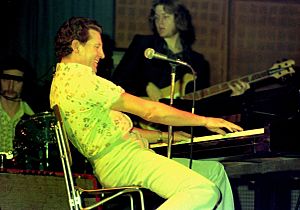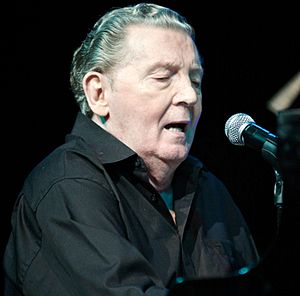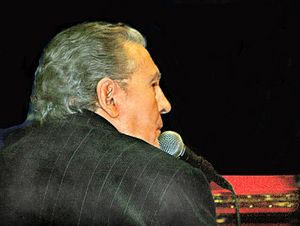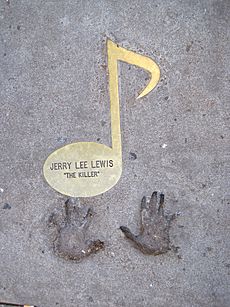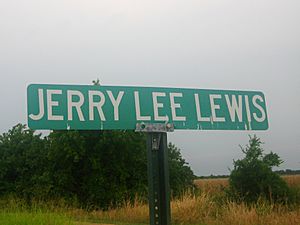Jerry Lee Lewis facts for kids
Quick facts for kids
Jerry Lee Lewis
|
|
|---|---|
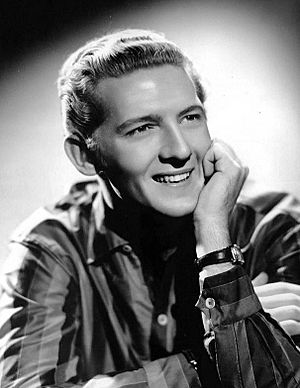
Lewis in a 1950s publicity portrait
|
|
| Born | September 29, 1935 Ferriday, Louisiana, U.S.
|
| Died | October 28, 2022 (aged 87) Nesbit, Mississippi, U.S.
|
| Occupation |
|
| Years active | 1949–2022 |
| Spouse(s) |
Dorothy Barton
(m. 1952; div. 1953)Jane Mitcham
(m. 1953; div. 1957)Myra Gale Brown
(m. 1957; div. 1970)Jaren Elizabeth Gunn Pate
(m. 1971; died 1982)Shawn Stephens
(m. 1983; died 1983)Karrie McCarver
(m. 1984; div. 2005)Judith Brown
(m. 2012) |
| Children | 6 |
| Relatives |
|
| Musical career | |
| Genres | |
| Instruments |
|
| Labels |
|
| Associated acts |
|
Jerry Lee Lewis (September 29, 1935 – October 28, 2022) was an American singer, songwriter and pianist. Nicknamed "The Killer", he was described as "rock & roll's first great wild man". A pioneer of rock and roll and rockabilly music, Lewis made his first recordings in 1952 at Cosimo Matassa's J&M Studio in New Orleans, Louisiana, and early recordings in 1956 at Sun Records in Memphis, Tennessee. "Crazy Arms" sold 300,000 copies in the South, but it was his 1957 hit "Whole Lotta Shakin' Goin' On" that shot Lewis to worldwide fame. He followed this with the major hits "Great Balls of Fire", "Breathless", and "High School Confidential". His rock and roll career faltered in the wake of his marriage to Myra Gale Brown, his 13-year-old cousin once removed.
His popularity quickly eroded following the scandal and with few exceptions such as a cover of Ray Charles's "What'd I Say", he did not have much chart success in the early 1960s. His live performances at this time were increasingly wild and energetic. His 1964 live album Live at the Star Club, Hamburg is regarded by many music journalists and fans in general as one of the wildest and greatest live rock albums ever. In 1968, Lewis made a transition into country music and had hits with songs such as "Another Place, Another Time". This reignited his career, and throughout the late 1960s and 1970s he regularly topped the country-western charts; throughout his seven-decade career, Lewis had 30 songs reach the Top 10 on the Billboard Country and Western Chart. His No. 1 country hits included "There Must Be More to Love Than This", "Would You Take Another Chance on Me", and "Me and Bobby McGee".
Lewis's successes continued throughout the decades and he embraced his rock and roll past with songs such as a cover of The Big Bopper's "Chantilly Lace" and Mack Vickery's "Rockin' My Life Away". In the 21st century, Lewis continued to tour around the world and released new albums. His 2006 album Last Man Standing was his best selling release, with over a million copies worldwide. This was followed by Mean Old Man in 2010, another of his bestselling albums.
Lewis had a dozen gold records in rock and country. He won four Grammy awards, including a Grammy Lifetime Achievement Award and two Grammy Hall of Fame Awards. Lewis was inducted into the Rock and Roll Hall of Fame in 1986 and his pioneering contribution to the genre was recognized by the Rockabilly Hall of Fame. He was also a member of the inaugural class inducted into the Memphis Music Hall of Fame. He was inducted into the Country Music Hall of Fame in 2022. In 1989, his life was chronicled in the movie Great Balls of Fire, starring Dennis Quaid. In 2003, Rolling Stone listed his box set All Killer, No Filler: The Anthology at number 242 on their list of "500 Greatest Albums of All Time". In 2004, they ranked him No. 24 on their list of the 100 Greatest Artists of All Time. Lewis was the last surviving member of Sun Records' Million Dollar Quartet and the album Class of '55, which also included Johnny Cash, Carl Perkins, Roy Orbison, and Elvis Presley.
Music critic Robert Christgau said of Lewis: "His drive, his timing, his offhand vocal power, his unmistakable boogie-plus piano, and his absolute confidence in the face of the void make Jerry Lee the quintessential rock and roller."
Early life
Lewis was born to Elmo Kidd Lewis Sr. and Mary "Mamie" Herron Lewis in Ferriday, Louisiana. He grew up in an impoverished farming family in Eastern Louisiana. In his youth, he began playing the piano with two of his cousins, Mickey Gilley (later a popular country music singer) and Jimmy Swaggart (later a popular televangelist). His parents mortgaged their farm to buy him a piano. Lewis was influenced by a piano-playing older cousin, Carl McVoy (who later recorded with Bill Black's Combo), the radio, and the sounds from Haney's Big House, a black juke joint across the tracks. On November 19, 1949, Lewis made his first public performance of his career, playing with a country and western band at a car dealership in Ferriday. The hit of his set was a cover of R&B artist Sticks McGhee's "Drinkin' Wine, Spo-Dee-O-Dee". On the live album By Request, More of the Greatest Live Show on Earth, Lewis is heard naming Moon Mullican as an artist who inspired him.
His mother enrolled him at the Southwest Bible Institute in Waxahachie, Texas, so that he could sing evangelical songs exclusively. When Lewis daringly played a boogie-woogie rendition of "My God Is Real" at a church assembly, it ended his association with the school the same night. Pearry Green, then president of the student body, related how during a talent show Lewis played some "worldly" music. The next morning, the dean of the school called Lewis and Green into his office to expel them. After that incident, he went home and started playing at clubs in and around Ferriday and Natchez, Mississippi, becoming part of the burgeoning new rock and roll sound and cutting his first demo recording in 1952 for Cosimo Matassa in New Orleans. Around 1955, he traveled to Nashville, where he played in clubs and attempted to build interest, but was turned down by the Grand Ole Opry, as he was already at the Louisiana Hayride country stage and radio show in Shreveport.
Career
J&M Studio
Lewis made his first recordings in 1952 at Cosimo Matassa's J&M Studio in New Orleans, Louisiana. He covered Lefty Frizzell's "Don't Stay Away (Till Love Grows Cold)" and his own instrumental composition "Jerry's Boogie" (AKA New Orleans Boogie).
Sun Records
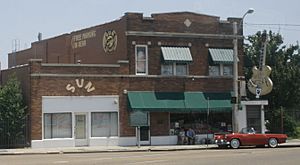
In November 1956, Lewis traveled to Memphis, Tennessee, to audition for Sun Records. Label owner Sam Phillips was in Florida, but producer and engineer Jack Clement recorded Lewis's rendition of Ray Price's "Crazy Arms" and his own composition "End of the Road". In December 1956, Lewis began recording prolifically as a solo artist and as a session musician for other Sun artists, including Carl Perkins and Johnny Cash. His distinctive piano playing can be heard on many tracks recorded at Sun in late 1956 and early 1957, including Carl Perkins's "Matchbox", "Your True Love", and "Put Your Cat Clothes On" and Billy Lee Riley's "Flyin' Saucers Rock'n'Roll".
On December 4, 1956, Elvis Presley dropped in on Phillips to pay a social visit while Perkins was in the studio cutting new tracks with Lewis backing him on piano. Johnny Cash was also there watching Perkins. The four then started an impromptu jam session and Phillips left the tape running. These recordings, almost half of which were gospel songs, were released on CD as Million Dollar Quartet. Tracks also include Elvis Presley's "Don't Be Cruel" and "Paralyzed", Chuck Berry's "Brown Eyed Handsome Man", and Pat Boone's "Don't Forbid Me".
Lewis's own singles (on which he was billed as "Jerry Lee Lewis And His Pumping Piano") advanced his career as a soloist during 1957, with hits such as "Whole Lotta Shakin' Goin' On", a Big Maybelle cover, and "Great Balls of Fire", his biggest hit, bringing him international fame and criticism of the songs, which prompted some radio stations to boycott them. In 2005, "Whole Lotta Shakin' Goin' On" was selected for permanent preservation in the National Recording Registry of the Library of Congress. According to several first-hand sources, including Johnny Cash, Lewis, a devout Christian, was troubled by the sinful nature of his own material, which he believed was leading him and his audience to Hell. This aspect of Lewis's character was depicted in Waylon Payne's portrayal of Lewis in the 2005 film Walk the Line, based on Cash's autobiographies.
As part of his stage act, Lewis pounded the keys with his heel, kicked the piano bench aside and played standing, raking his hands up and down the keys, sat on the keyboard and stood on the piano. He told the Pop Chronicles that kicking over the bench originally happened by accident, but when it got a favorable response, he kept it in the act. His inaugural television appearance, in which he demonstrated some of these moves, was on The Steve Allen Show on July 28, 1957, where he played "Whole Lotta Shakin' Goin On".
His dynamic performance style can be seen in films such as High School Confidential (he sang the title song from the back of a flatbed truck), and Jamboree. Cub Koda called him "rock & roll's first great wild man" and also "rock & roll's first great eclectic". Classical composer Michael Nyman has also cited Lewis's style as the progenitor of his own aesthetic.
Marriage controversy
Lewis's turbulent personal life was hidden from the public until a May 1958 British tour where Ray Berry, a news agency reporter at London's Heathrow Airport (the only journalist present), learned about Lewis's third wife, Myra Gale Brown. She is Lewis's first cousin once removed and was 13 years old when they married—though Lewis, who was 22 years old at the time, claimed she was actually 15. The publicity caused an uproar, and the tour was canceled after only three concerts.
In 1960, Phillips opened a new state-of-the-art studio at 639 Madison Avenue in Memphis, abandoning the old Union Avenue studio where Phillips had recorded B.B. King, Howlin' Wolf, Elvis Presley, Roy Orbison, Carl Perkins, Lewis, Johnny Cash, and others, and also opened a studio in Nashville. It was at the latter studio that Lewis recorded his only major hit during this period, a rendition of Ray Charles's "What'd I Say" in 1961. In Europe, other updated versions of "Sweet Little Sixteen" (September 1962 UK) and "Good Golly, Miss Molly" (March 1963) entered the hit parade. On popular EPs, "Hang Up My Rock and Roll Shoes", "I've Been Twistin'", "Money", and "Hello Josephine" also became turntable hits, especially in nascent discothèques. Another recording of Lewis playing an instrumental boogie arrangement of the Glenn Miller Orchestra's "In the Mood" was issued on the Phillips International label under the pseudonym "The Hawk".
Smash Records
Lewis's Sun recording contract ended in 1963, and he joined Smash Records, where he made several rock recordings that did not further his career. The team at Smash (a division of Mercury Records) came up with "I'm on Fire", a song that they felt would be perfect for Lewis and, as Colin Escott writes in the sleeve to the retrospective A Half Century of Hits, "Mercury held the presses, thinking they had found Lewis's comeback hit, and it might have happened if the Beatles hadn't arrived in America, changing radio playlists almost overnight. Mercury didn't really know what to do with Lewis after that." One of Smash's first decisions was to record a retread of his Sun hits, Golden Hits of Jerry Lee Lewis, which was inspired by the continuing enthusiasm European fans had shown for Lewis's firebrand rock and roll. In June 1963, Lewis returned to the UK for the first time since the scandal that nearly ended his career five years earlier, to headline a performance on the MV Royal Daffodil, for a cross-channel rock and roll cruise from Southend, Essex, to Boulogne, France. For this performance, he was backed by Ritchie Blackmore and the Outlaws. None of Lewis's early Smash albums, including The Return of Rock, Memphis Beat, and Soul My Way, were commercial successes.
Live at the Star Club, Hamburg
One major success during these lost years was the concert album Live at the Star Club, Hamburg, recorded with the Nashville Teens in 1964, which is considered one of the greatest live albums ever. In Joe Bonomo's book Lost and Found, producer Siggi Loch stated that the recording setup was uncomplicated, with microphones placed as close to the instruments as possible and a stereo mic placed in the audience to capture the ambience. The results were sonically astonishing, with Bonomo observing, "Detractors complain of the album's crashing noisiness, the lack of subtlety with which Jerry Lee revisits the songs, the fact that the piano is mixed too loudly, but what is certain is that Siggi Loch on this spring evening captured something brutally honest about the Killer, about the primal and timeless centre of the very best rock & roll..." The album showcases Lewis's skills as a pianist and singer, honed by relentless touring. In a 5-out-of-5-stars review, Milo Miles wrote in Rolling Stone magazine that "Live at the Star Club, Hamburg is not an album, it's a crime scene: Jerry Lee Lewis slaughters his rivals in a thirteen-song set that feels like one long convulsion."
Country comeback
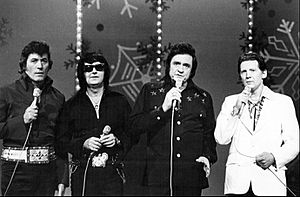
Frustrated by Smash's inability to score a hit, Lewis was planning on leaving the label when promotions manager Eddie Kilroy called him and pitched the idea of cutting a pure country record in Nashville. With nothing to lose, Lewis agreed to record the Jerry Chesnut song "Another Place, Another Time", which was released as a single on March 9, 1968, and, to everyone's amazement, shot up the country charts. At the time of the release, Lewis had been playing Iago in a rock and roll adaptation of Othello called Catch My Soul in Los Angeles but was soon rushed back to Nashville to record another batch of songs with producer Jerry Kennedy. What followed was a string of hits that no one could have ever predicted, although country music always remained a major part of Lewis's repertoire. As Colin Escott observes in the sleeve to the 1995 compilation Killer Country, the conversion to country music in 1968 "looked at the time like a radical shift, but it was neither as abrupt nor as unexpected as it seemed. Jerry had always recorded country music, and his country breakthrough "Another Place, Another Time" had been preceded by countless country records starting with his first, 'Crazy Arms', in 1956." The last time Lewis had had a song on the country charts was with "Pen and Paper" in 1964, which had reached number 36, but "Another Place, Another Time" would go all the way to number 4 and remain on the charts for 17 weeks.
Between 1968 and 1977, Lewis had 17 Top 10 hit singles on the Billboard country chart, including four chart-toppers. Hits include "What's Made Milwaukee Famous (Has Made A Loser Out of Me)", "She Still Comes Around (To Love What's Left of Me)", "Since I Met You Baby", "Once More With Feeling", "One Has My Name (The Other Has My Heart)", and "Sometimes A Memory Ain't Enough". The production on his early country albums, such as Another Place, Another Time and She Even Woke Me Up To Say Goodbye, was sparse, quite different from the slick "Nashville sound" that was predominant on country radio at the time, and also expressed a full commitment by Lewis to a country audience. The songs still featured Lewis's inimitable piano flourishes, but critics were most taken aback by the rock and roll pioneer's effortlessly soulful vocals, which possessed an emotional resonance on par with the most respected country singers of the time, such as George Jones and Merle Haggard. In his book Jerry Lee Lewis: His Own Story, biographer Rick Bragg notes that the songs Lewis was recording "were of the kind they were starting to call 'hard country', not because it had a rock beat or crossed over into rock in a real way, but because it was more substantial than the cloying, overproduced mess out there on country radio".
In a remarkable turnaround, Lewis became the most bankable country star in the world. He was so huge in 1970 that his former Smash producer Shelby Singleton, who purchased Sun Records from Sam Phillips in July 1969, wasted no time in repackaging many of Lewis's old country recordings with such effectiveness that many fans assumed they were recent releases. One of his latter unreleased Sun recordings, "One Minute Past Eternity", was issued as a single and soared to number 2 on the country chart, following Lewis's recent Mercury hit "She Even Woke Me Up To Say Goodbye". Singleton would milk these unreleased recordings for years, following The Golden Cream of the Country with A Taste of Country later in 1970.
Grand Ole Opry appearance
Lewis played the Grand Ole Opry for the first and only time on January 20, 1973. As Colin Escott writes in the liner notes to A Half Century of Hits, he had maintained an ambivalence to Music City ever since he was turned away as an aspiring musician before his glory days at Sun Records: "It was 18 years since he had left Nashville broke and disheartened...Lewis was never truly accepted in Nashville. He didn't move there and didn't schmooze there. He didn't fit in with the family values crowd. Lewis family values weren't necessarily worse, but they were different."
As recounted in a 2015 online Rolling Stone article by Beville Dunkerly, Lewis opened with his comeback single "Another Place, Another Time". Ignoring his allotted time constraints— and, thus, commercial breaks— Lewis played for 40 minutes (the average Opry performance is two songs, for about eight minutes of stage time maximum) and invited Del Wood— the one member of the Opry who had been kind to him when he had been there as a teenager— out on stage to sing with him. He also blasted through "Whole Lotta Shakin' Going On", "Workin' Man Blues", "Good Golly, Miss Molly", and a host of other classics.
The Session and Southern Roots
Lewis returned to the pop charts with "Me and Bobby McGee" in 1971 and "Chantilly Lace" in 1972, and this turn of events, coupled with a revitalized public interest in vintage rock and roll, inspired Mercury to fly Lewis to London in 1973 to record with a cadre of British and Irish musicians, including Rory Gallagher, Kenney Jones, and Albert Lee. By all accounts the sessions were tense. The remake of Lewis's old Sun cut "Drinking Wine Spo-Dee-O-Dee" was the album's hit single, reaching number 20 on the Billboard country chart and peaking at number 41 on the pop chart. The Session was his highest pop charting album since 1964's Golden Hits of Jerry Lee Lewis, hitting number 37. It did far better on the country albums chart, rising to number 4. Later that year, he went to Memphis and recorded Southern Roots: Back Home to Memphis, a soul-infused rock album produced by Huey Meaux.
Lewis was still pumping out country albums, although the hits were beginning to dry up. His last big hit with Mercury was "Middle Age Crazy", which made it to number 4 in 1977.
Later career
In 1979, Lewis switched record labels to Elektra and produced the critically acclaimed Jerry Lee Lewis, although sales were disappointing. In 1986, Lewis was one of the inaugural inductees into the Rock and Roll Hall of Fame. Although looking frail after several hospitalizations due to stomach problems, Lewis was responsible for beginning an unplanned jam at the end of the evening, which was eventually incorporated into all future events. That year, he returned to Sun Studio in Memphis to team up with Orbison, Cash, and Perkins along with longtime admirers like John Fogerty to create the album Class of '55.
In 1989, a major motion picture based on his early life in rock and roll, Great Balls of Fire!, brought him back into the public eye, especially when he decided to re-record all his songs for the movie soundtrack. The film was based on the book by Lewis's ex-wife, Myra Gale Lewis, and starred Dennis Quaid as Lewis, Winona Ryder as Myra, and Alec Baldwin as Jimmy Swaggart. The movie focuses on Lewis's early career and his relationship with Myra and ends with the scandal of the late 1950s. A year later, in 1990, Lewis made minor news when a new song he recorded called "It Was the Whiskey Talkin' (Not Me)" was included in the soundtrack to the hit movie Dick Tracy. The song is also heard in the movie, playing on the radio. The public downfall of his cousin, televangelist Jimmy Swaggart around the same time, resulted in more adverse publicity to a troubled family. Swaggart is also a piano player, as is another cousin, country music star Mickey Gilley. All three listened to the same music in their youth and frequented Haney's Big House, the Ferriday club that featured black blues acts. Lewis and Swaggart had a complex relationship over the years.
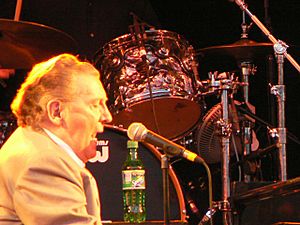
In 1998, Lewis toured Europe with Chuck Berry and Little Richard. On February 12, 2005, he was given a Lifetime Achievement Award by The Recording Academy. On September 26, 2006, a new album titled Last Man Standing was released, featuring many of rock and roll's elite as guest stars. Receiving positive reviews, the album charted on four different Billboard charts, including a two-week stay at number one on the Indie charts. A DVD entitled Last Man Standing Live, featuring concert footage with many guest artists, was released in March 2007.
In October 2008, as part of a successful European tour, Lewis appeared at two London shows: a special private show at the 100 Club on October 25 and at the London Forum on October 28 with Wanda Jackson and his sister, Linda Gail Lewis. In August 2009, in advance of his new album, a single entitled "Mean Old Man" was released for download. It was written by Kris Kristofferson. An EP featuring this song and four more was also released on November 11. On October 29, 2009, Lewis opened the Rock and Roll Hall of Fame 25th Anniversary concert at Madison Square Garden in New York City.
In May 2013, Lewis opened a new club on Beale Street in Memphis. Lewis was still considered actively performing in concert, though he had to cancel all shows following his February 28, 2019, stroke, waiting for his doctors' go-ahead.
In 2017 Lewis had a personal presence at The Country Music Television Skyville Live show. It was a specially recorded performance featuring a whole array of artists paying tribute to the music of Lewis.
In March 2020, it was announced that Lewis, together with producer T-Bone Burnett, was recording a new album of gospel covers. It was the first time he entered a recording studio following his stroke.
On October 27, 2020, to celebrate Lewis's 85th birthday, a livestream aired on YouTube, Facebook, and his official website. The livestream special, Whole Lotta Celebratin' Goin' On, featured appearances and performances by Willie Nelson, Elton John, Mike Love, Priscilla Presley, Joe Walsh, and others. John Stamos served as the host.
Jerry Lee Lewis: Trouble in Mind is the title of a documentary on Lewis released in 2022 and directed by Ethan Coen. Earlier in 2022, a collaborative gospel album was released with Jerry Lee Lewis and his cousin Jimmy Swaggart, called The Boys from Ferriday.
Music legacy
Accolades
Along with Johnny Cash, Carl Perkins, and Roy Orbison, Lewis received the first Grammy Award in the spoken-word category for the very rare album of interviews released with some early copies of the Class of '55 album in 1986. The original Sun cut of "Great Balls of Fire" was elected to the Grammy Hall of Fame in 1998, and Lewis's Sun recording of "Whole Lotta Shakin' Goin On" received this honor in 1999. Only recordings that are at least 25 years old and have left a lasting impression can receive this honor. On February 12, 2005, Lewis received the Recording Academy's Lifetime Achievement Award the day before the Recording Academy's main Grammy Awards ceremony, which he also attended.
In June 1989, Lewis was honored for his contribution to the recording industry with a star along Hollywood Boulevard on the Hollywood Walk of Fame. On October 10, 2007, Lewis received the Rock and Roll Hall of Fame's American Music Masters Award. His next album, Mean Old Man, was released in September 2010 and reached No. 30 on the Billboard 200 album chart.
On November 5, 2007, the Rock and Roll Hall of Fame and Case Western Reserve University in Cleveland, Ohio, honored Lewis with six days of conferences, interviews, a DVD premiere, and film clips, dedicated to him and entitled The Life And Music of Jerry Lee Lewis. On November 10, the week culminated with a tribute concert compered by Kris Kristofferson. Lewis was present to accept the American Music Masters Award and closed his own tribute show with a rendition of "Over the Rainbow". On February 10, 2008, he appeared with John Fogerty and Little Richard on the 50th Grammy Awards, performing "Great Balls of Fire" in a medley with "Good Golly Miss Molly". On June 4, 2008, Lewis was inducted into the Louisiana Music Hall of Fame and appeared on A Capitol Fourth and performed the finale's final act with a medley of "Roll Over Beethoven", "Whole Lotta Shakin' Goin On", and "Great Balls of Fire".
In December 2019, Lewis was honored with a Mississippi Country Music Trail marker at his ranch in Nesbit, Mississippi to celebrate his contributions to country music.
In May 2022, Lewis was announced as a member-elect to the Country Music Hall of Fame, to be inducted in October 2022. "This year's inductees are trailblazers who each paved their own unique path within country music," Sarah Trahern, CMA Chief Executive Officer, said. "Jerry Lee, Keith (Whitley), and Joe (Galante) each found their musical callings early in life and displayed a strong-minded and fierce passion for music making. In very different ways, they all have left a lasting impact on the industry and generations of fans alike. I am thrilled to welcome this deserving class to the Country Music Hall of Fame." "I'm just overwhelmed that they asked me here today," Lewis, 86, said during an event earlier that week at the Country Music Hall of Fame in Nashville, adding that his career had taught him to "be a good person and treat people right."
Piano style
Lewis was an incendiary showman who often played with his fists, elbows, feet, and backside, sometimes climbing on top of the piano during gigs and even apocryphally setting it on fire. Like Chuck Berry's guitar playing, Lewis's piano style became synonymous with rock and roll, having influenced generations of piano players.
Although Lewis's piano playing is commonly labeled boogie-woogie, gospel music was another major influence in the formation of his technique. In Joe Bonomo's 2009 book Jerry Lee Lewis: Lost and Found, Memphis producer and musician Jim Dickinson calls Lewis's occasional penchant for interrupting the standard boogie woogie left-hand progression by omitting the seventh and repeating the fifth and sixth, creating a repetitive, driving, quasi-menacing momentum, "revolutionary, almost inexplicable. Maybe Ella Mae Morse, Moon Mullican had done it, but not in a way that became the propelling force of the song. Rock and roll piano up to that point had been defined by Rosco Gordon, Ike Turner, and to an extent, Ray Charles. None of them was doing that. Even Little Richard, as primitive as he plays, wasn't doing that shuffle... There was something in Jerry Lee that didn't want to play that seventh, and that's the church. Certainly in white spiritual music you avoid sevenths."
Personal life
Relationships and children
Lewis was married seven times, including bigamous marriages and a marriage with his underage cousin. He had six children during his marriages.
When Jerry Lee Lewis was 16, he married Dorothy Barton, the daughter of a preacher. Their union lasted for 20 months, from February 1952 to October 1953.
Lewis's second marriage in September 1953, to Sally Jane Mitcham, was of dubious validity because it occurred 23 days before his divorce from Barton was final. After four years, he filed for divorce in October 1957. They had two children: Jerry Lee Lewis Jr. (1954–1973) and Ronnie Guy Lewis (b. 1956). In 1973, Jerry Lee Lewis Jr. died at the age of 19 when he overturned the Jeep he was driving.
His third marriage was to 13-year-old Myra Gale Brown, his first cousin once removed, on December 12, 1957. His divorce from Jane Mitcham was not finalized before the ceremony took place, so he remarried Brown on June 4, 1958. They had two children: Steve Allen Lewis (1959–1962) and Phoebe Allen Lewis (b. 1963). Brown was only 14 years old when her son was born. In 1962, Steve Allen Lewis drowned in a swimming pool accident at the age of 3. In 1970, Brown filed for divorce.
His fourth marriage was to Jaren Elizabeth Gunn Pate from October 1971 to June 8, 1982. Pate drowned in a swimming pool at the home of a friend with whom she was staying, several weeks before divorce proceedings could be finalized. They had one daughter, Lori Lee Lewis (b. 1972).
Mary Kathy "K.K." Jones of San Antonio, Texas, testified in court during Lewis's income tax evasion trial in 1984 that she lived with him from 1980 to 1983.
Lewis's fifth marriage, to Shawn Stephens, lasted 77 days, from June to August 1983, ending with her death.
His sixth marriage, to Kerrie McCarver, lasted 21 years, from April 1984 to June 2005. They had one child: Jerry Lee Lewis III (b. 1987).
In 1993, Lewis moved to Ireland with his family in what was suggested (but denied) to be a move to avoid issues with the Internal Revenue Service. He lived in a rented house on Westminster Road in Foxrock, Dublin, and during his time there was sued by the German company Neue Constantin Film Production GmbH for failure to appear at a concert in Munich in 1993. Lewis returned to the U.S. in 1997 after his tax issues had been resolved by Irish promoter Kieran Cavanagh.
Lewis lived on a ranch in Nesbit, Mississippi, with his family.
Lewis married his seventh wife Judith Lewis (née Brown, Myra Gale Brown's brother's former wife) on March 9, 2012. The next day, Lewis severed business ties with his daughter, Phoebe Lewis-Loftin, who was his manager, and revoked her power of attorney. In 2017, Lewis sued his daughter and her husband Zeke Loftin claiming that she owed him "substantial sums of money". In the lawsuit, Lewis, his wife Judith Lewis, and his son Jerry Lee Lewis III also claimed Loftin defamed them on Facebook. Lewis-Loftin and her husband counter-sued, claiming Judith Lewis and Jerry Lee Lewis III interfered in the business relationship. In April 2019, U.S. District Judge Neal Biggers ruled that most of the claims were barred by a three-year statute of limitations except the defamation claims.
Religious beliefs
As a teenager, Lewis studied at the Southwest Bible Institute in Waxahachie, Texas, before being thrown out for daring to play a boogie-woogie version of "My God Is Real", and that early incident foreshadowed his lifelong conflict over his faith in God and his love of playing "the devil's music". Lewis had a recorded argument with Sam Phillips during the recording session for "Great Balls of Fire", a song he initially refused to record because he considered it blasphemous ("How can… How can the devil save souls? What are you talkin' about?" he asks Phillips during one heated exchange.) During the famous Million Dollar Quartet jam involving Lewis, Elvis Presley, Carl Perkins, and Johnny Cash, they performed several gospel songs. Lewis's biographer Rick Bragg explains that part of the reason the recording only features Lewis and Elvis singing is because "only Elvis and Jerry Lee [were] raised in the Assembly of God", and "'Johnny and Carl didn't really know the words... they was Baptists', [Lewis] said, and therefore deprived."
In the 1990 documentary The Jerry Lee Lewis Story, Lewis said to the interviewer, "The Bible doesn't even speak of religion. No word of religion is even in the Bible. Sanctification! Are you sanctified? Have you been saved? See, I was a good preacher, I know my Bible? I find myself falling short of the glory of God."
Gospel music was a staple of his performing repertoire. After a string of hit country albums, he decided to record a gospel album for the first time in 1970 (it was released in 1971).
Lewis was also a cousin of the televangelist Jimmy Swaggart.
Debt

In 1979, the IRS seized property from Lewis to compensate a $274,000 tax debt. The property included several automobiles, a tractor, five motorcycles, jewelry, musical instruments, home entertainment equipment, and firearms. In 1980, an auction was held, but only 150 potential bidders showed up. The auction amassed $91,382, a third of the debt.
In 1984, Lewis was found innocent of evading taxes. The next year, the IRS seized property from his Nesbit, Mississippi ranch.
In 1988, Lewis filed for bankruptcy, petitioning that he was more than $3 million in debt, including $2 million he owed to the IRS.
Health and death
Lewis had a minor stroke in Memphis on February 28, 2019. He had to cancel several appearances.
Lewis died at his home on October 28, 2022, in Nesbit, Mississippi, following a bout of pneumonia, at the age of 87.
Lewis' funeral was held on November 5, 2022, in his hometown of Ferriday, Louisiana. The service was officiated by his cousin, the televangelist Jimmy Swaggart and Swaggart's son.
Selected discography
- Jerry Lee Lewis (1958)
- Jerry Lee's Greatest! (1962)
- Live at the Star Club, Hamburg (1964)
- The Return of Rock (1965)
- Country Songs for City Folks/All Country (1965)
- Memphis Beat (1966)
- Soul My Way (1967)
- Another Place, Another Time (1968)
- She Still Comes Around (1969)
- Sings the Country Music Hall of Fame Hits, Vol. 1 (1969)
- Sings the Country Music Hall of Fame Hits, Vol. 2 (1969)
- The Golden Cream of the Country (1969)
- She Even Woke Me Up to Say Goodbye (1970)
- A Taste of Country (1970)
- There Must Be More to Love Than This (1971)
- Touching Home (1971)
- Would You Take Another Chance on Me? (1971)
- The Killer Rocks On (1972)
- Who's Gonna Play This Old Piano? (1972)
- The Session...Recorded in London with Great Artists (1973)
- Sometimes a Memory Ain't Enough (1973)
- Southern Roots: Back Home to Memphis (1973)
- I-40 Country (1974)
- Boogie Woogie Country Man (1975)
- Odd Man In (1975)
- Country Class (1976)
- Country Memories (1977)
- Jerry Lee Keeps Rockin' (1978)
- Jerry Lee Lewis (1979)
- When Two Worlds Collide (1980)
- Killer Country (1980)
- Class of '55 (1986)
- Young Blood (1995)
- Last Man Standing (2006)
- Last Man Standing Live (2007)
- Mean Old Man (2010)
- Rock and Roll Time (2014)
Compositions
Lewis wrote or co-wrote the following songs: "End of the Road" (1956), "Lewis Boogie" (1956), "Pumpin' Piano Rock" (1957), "High School Confidential" (1958), "Memory of You" (1958), "Baby Baby Bye Bye" (1960), although Discogs credits Jerry Lee Lewis and Huey "Piano" Smith as the songwriters, the song was copyrighted in 1960 as by Lewis Smith, "Lewis Workout" (1960), "He Took It Like a Man" (1963, from the 1967 album Soul My Way), "Baby, Hold Me Close" (1965) from the 1965 album The Return of Rock, "What a Heck of a Mess" (1966), "Lincoln Limousine" (1966), "Alvin" (1970), "Wall Around Heaven" from the 1972 album Who's Gonna Play This Old Piano?, "Rockin' Jerry Lee" (1980, the B side of "Honky Tonk Stuff", from the album When Two Worlds Collide), "Pilot Baby" (1983), "Crown Victoria Custom '51" (1995), released as a Sire 45 single B side, and "Ol' Glory" (2006) from the album Last Man Standing.
See also
 In Spanish: Jerry Lee Lewis para niños
In Spanish: Jerry Lee Lewis para niños


